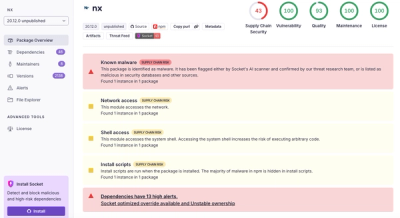
Security News
/Research
Wallet-Draining npm Package Impersonates Nodemailer to Hijack Crypto Transactions
Malicious npm package impersonates Nodemailer and drains wallets by hijacking crypto transactions across multiple blockchains.
error-label
Advanced tools
<error-label>Simple, declarative, accessible error labeling.
<form>
<label for="email-input">Email</label>
<input id="email-input" type="email">
<error-label for="email-input" type="typeMismatch">Not a valid email.</error-label>
</form>
Form validation with descriptive error messages is an annoying task that is necessary in almost every web development project.
The <error-label> custom element builds off of the browser's default <label> element and Constraint Validation API to take the effort out of this common task, allowing developers to stay DRY.
The guiding philosopy of this project is that good error labels should require little to no custom JavaScript.
The <error-label> custom element works much like the default <label> element. Error labels are linked to inputs using the for attribute: <error-label for="inputId"></error-label>
However, error labels are not displayed to the user by default. They are only visible if the error designated in the type attribute has occured: <error-label for="inputId" type="errorId"></error-label>
Without providing any custom errors, the <error-label> component will support all of the default errors defined by the Constraint Validation API:
badInputpatternMismatchrangeOverflowrangeUnderflowstepMismatchtooLongtooShorttypeMismatchvalidvalueMissing<form>
<label for="password-input">Password</label>
<input id="password-input" type="password" minlength="6">
<error-label for="password-input" type="tooShort">Your password must be at least 6 characters long.</error-label>
</form>
You can provide any custom message or HTML inside of an <error-label>.
In addition to this, you can also use the {{value}} variable to access the raw user input value, or the {{length}} variable to access its length.
<form>
<label for="num-input">Enter a number</label>
<input id="num-input" type="number">
<error-label for="num-input" type="badInput">{{value}} is not a number.</error-label>
</form>
You can also provide your own custom error types by providing a config object to the parent <form> element's data-error-config attribute.
<form data-error-config="errorLabelConfig">
<label for="name-input">Name</label>
<input id="name-input">
<error-label for="name-input" type="badLang">Please don't say that.</error-label>
</form>
<script>
errorLabelConfig = {
errors: {
'badLang': target => target.value.includes('butt'),
}
}
</script>
Custom errors are added to the config objects error property. Custom errors are represented as functions that return a boolean value, where a truthy return value indicates the error is present.
Returning a non-empty string will use it as the default message for that error:
<form data-error-config="errorLabelConfig">
<label for="name-input">Name</label>
<input id="name-input">
<error-label for="name-input" type="badLang"></error-label>
</form>
<script>
errorLabelConfig = {
errors: {
'badLang': target => target.value.includes('butt') ? `Please don't say ${target.value}.` : false,
}
}
</script>
Error labels can also be grouped together to avoid repetition. Attributes defined on the group will be inherited by the error labels within.
<label for="email-input2">Error-Group Email</label>
<input id="email-input2" minlength="5" type="email">
<error-label-group for="email-input2">
<error-label type="typeMismatch">Not a valid email.</error-label>
<error-label type="tooShort">Way too short buddy!</error-label>
</error-label-group>
Error groups can also copy content from <template> elements, to allow for reusable default messages.
<template id="default-errors">
<error-label type="typeMismatch">Not a valid email.</error-label>
<error-label type="tooShort">Way too short!</error-label>
</template>
<error-label-group template="default-errors" for="email-input"></error-label-group>
Error labels and groups can be styled using plain CSS:
<style>
error-label {
color: red;
display: block;
margin: .5em;
margin-top: 1em;
}
error-label:not([hidden])::before {
content: '* '
}
error-label-group {
display: block;
}
</style>
https://www.gnu.org/licenses/gpl-3.0.en.html
A more permissive enterprise license is also available. Please direct all related inquiries here.
FAQs
A web component error labeling.
We found that error-label demonstrated a not healthy version release cadence and project activity because the last version was released a year ago. It has 1 open source maintainer collaborating on the project.
Did you know?

Socket for GitHub automatically highlights issues in each pull request and monitors the health of all your open source dependencies. Discover the contents of your packages and block harmful activity before you install or update your dependencies.

Security News
/Research
Malicious npm package impersonates Nodemailer and drains wallets by hijacking crypto transactions across multiple blockchains.

Security News
This episode explores the hard problem of reachability analysis, from static analysis limits to handling dynamic languages and massive dependency trees.

Security News
/Research
Malicious Nx npm versions stole secrets and wallet info using AI CLI tools; Socket’s AI scanner detected the supply chain attack and flagged the malware.